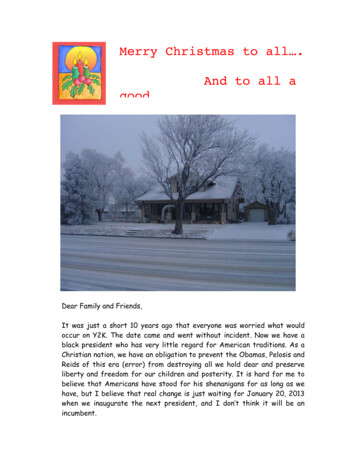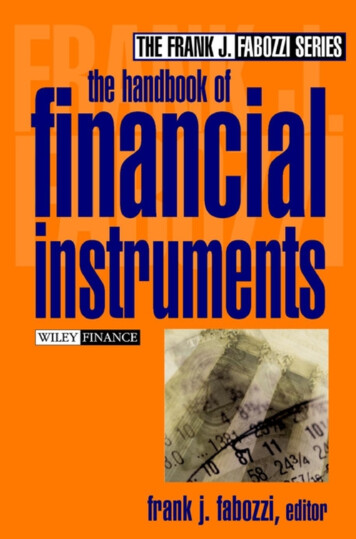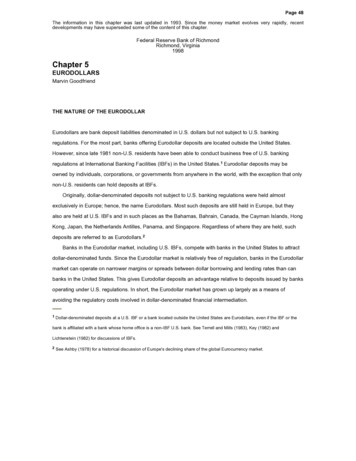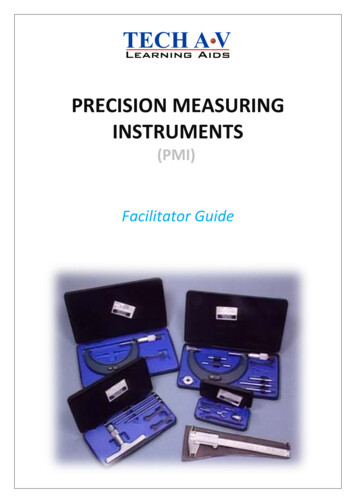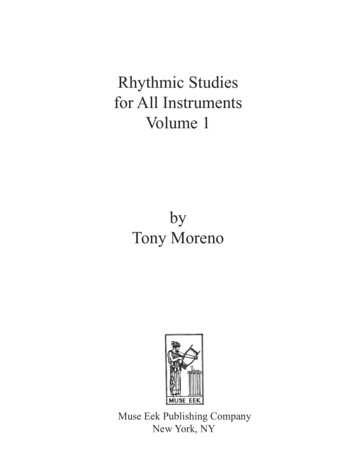
Transcription
Rhythmic Studiesfor All InstrumentsVolume 1byTony MorenoMuse Eek Publishing CompanyNew York, NY
Copyright 2006 by Muse Eek Publishing Company. All rights reservedISBN 159489-929-0No part of this publication may be reproduced, stored in aretrieval system, or transmitted, in any form or by any means,electronic, mechanical, photocopying, recording, or otherwise,without the prior written permission of the publisher.Printed in the United StatesThis publication can be purchased from your local bookstore or by contacting:Muse Eek Publishing CompanyP.O. Box 509New York, NY 10276, USAPhone: 212-473-7030Fax: com
AcknowledgementsTony would like to thank the following for their help and support: Bruce Arnold, Gabe Cummins, RonaldAndryshak, Marc Mommaas, Rich Mangicaro and everyone at Paiste America for their great support, Bob Moses, Elvin and Keiko, Stan Koor, Nina Dunkel, Emma, Antonio, Gene, and to all of my students and most of all,to Susan and Evan.
About the AuthorTony Moreno is from NYC. He attended and received his degree from the Manhattan School of Music. He studied privately with Stan Koor, Elvin Jones, Bob Moses and Al Kuumba Heath and James Preiss. Tony teaches atNew York University, Columbia University and the City College of NY. Tony has appeared on over 70 recordings, and travels extensively throughout the U.S. and Europe.
ForewardAs music evolves, so do the techniques, mechanics and esthetics that musicians use change and develop toexpress their new approaches to melody, harmony and rhythm. Improvising musicians have been creating andperforming music for thousands of years; as musicians who have studied jazz for a number of years can attest,this art form, by its very nature, will continue to evolve. And like all musicians, we draw much of our inspiration through studying the performances of all the great artists throughout the history of our music.With the continued development of melody, form and harmony, so has rhythm grown to encompass the concepts of many musicians that are introducing challenging new ideas based on meter and form. Since the introduction of African, Afro-Cuban, Indian, South Pacific and Asian music into American culture, musicians haveused these influences in both their compositions and improvising.By applying some of these ideas over standard forms, such as the blues, we can gain an understanding of howthese concepts can be applied to many different musical genres. But the idea for many of these exercises is togain more control over the basic quarter note, of pulse and of form.These exercises are also meant to be played with other musicians; they are not just solo studies. The best wayto learn these concepts is to work in any musical setting you can organize, be it duo, trio or quartet. Often youmay want to rehearse in a group setting with a metronome running to help guide the musicians. Once you andyour bandmates develop these ideas, begin writing and performing your own compositions and formulatingyour own ideas.
Table of ContentsAcknowledgementsAbout the AuthorForewardCounting and ClappingDotted Quarter Note Transposition of Harmonic Rhythm in “Blues for Alice”Three Bar Cycles of Dotted Quarter NotesAlternate Harmonic Rhythm #1Alternate Harmonic Rhythm #2“Blues for Alice” in Compound Meters“Blues for Alice” in 3/4“Blues for Alice” in 5/4 (3-2 subdivision)“Blues for Alice” in 6/4 (3-3 subdivision)“Blues for Alice” in 7/4 (4-3 subdivision)“Blues for Alice” in 5/4 (short form 3-2 subdivision)“Blues for Alice” in 7/4 (short form 4-3 subdivision)“Blues for Alice” trading 3 bar Phrases“Blues for Alice” trading 5 bar PhrasesSubdivisions with accents; subdivisions over a blues formMetric Modulation: triplets and quarter note tripletsMetric Modulation on the quarter note triplet levelMetric Modulation and Harmonic Rhythm on the quarter note triplet levelHarmonic Rhythm in the superimposed 3/4Quarter note triplet phrasing on downbeats and upbeats; introduction to half note tripletsHalf note triplet harmonic rhythmHalf note triplet phrasing with melodyQuintuplet subdivisions and Septuplet subdivisions“Blues for Alice” within 5 over 4 Metric Modulation“Blues for Alice” within 7 over 4 Metric 35363739
Counting and ClappingOne of the most efficient ways for developing a sense of rhythmic articulation is through the process of counting out loud and clapping. This is best done with a metronome when practicing alone, or in conjunction withanother musician. By counting out loud and vocalizing one rhythm while clapping another component of thephrase, we become aware of pulse on an internal level. Rhythm can appear as a three dimensional grid, withdifferent transparencies showing all the interlocking grids of one pattern over another. We can begin to feelrhythm as a dance, albeit a very precise and calibrated structure on which to build variations. Our wish is to create organic phrases that move fluidly, using space and creating drama. When practicing these exercises, alwayschoose tempos that allow you to comfortably hear the patterns. When having difficulty with a particular exercise, it’s best to stop and begin reducing the velocity (bpm) until you are able to hear and execute the exerciseproperly. It is important to keep this in mind when working on new musical ideas: continue slowing down thetempo on the metronome until you can play the beginning measure(s) correctly. Although the mechanics of yourperformance may seem rigid at these tempos, you must at least “hear” the basic principle before moving forward. And even at these slow tempos, you should continue to strive for musicality, phrasing and articulation.We will begin by applying a counting system first, and later substitute melody and form as our internal clave.In the same way that drummers would start to work on these exercises within a simple, time-keeping context,rhythm section instrumentalists would begin by comping and counting out loud (with a metronome). We need tohear the original harmonic rhythm and form, as well as altered variations or superimpositions, simultaneously.We begin by understanding these principles as supportive players, dealing with these concepts as accompaniststhereby fulfilling and deepening our roles as members of the rhythm section. Once this is accomplished, wehave the template for developing our linear (soloing) ideas within this new vocabulary.It’s best to start by using the metronome while counting out loud and clapping the rhythms. When working on aspecific rhythmic grouping (such as half note triplets), switch every 4 bars between your original or base meter(the metronome marking every quarter note in 4/4) which you are counting out loud: “1 and 2 and 3 and 4 and”while simultaneously clapping the grouping. It often helps to reinforce the base meter by tapping your foot oneach downbeat. You get the 3:4 feeling running through your limbs and voice, similar to how drummers are ableto mark time and tempo using a combination of all four limbs. After four bars, you would slightly reverse theprocess, and count the groupings out loud while clapping and tapping the base meter (4/4). In addition, I’ve always recommended using your laptop to create your own metronome, click track, sequence, whatever; we haveto often think outside the box, so any sequencing software will help you to create your own study loops. Buteven using the standard metronome, we can assign that instead of representing our base rhythm (quarter notesin 4/4), the metronome is actually counting half note triplets. It then becomes a matter of perception of what wewant the metronome to count for us. It can be much more than an eighth or quarter note.If the base rhythm is 4/4, there are a variety of ways you should practice counting out loud: 1) Counting onlythe downbeats: 1 2 3 4; 2) Counting the downbeats with eighth note subdivisions: “1 and 2 and 3 and 4 and” 3)Counting the downbeats with eighth note subdivisions and bar numbers: “1 and 2 and 3 and 4 and 2 and 2 and3 and 4 and 3 and 2 and 3 and 4 and 4 and 2 and 3 and 4 and” . Later, you will have to alter the subdivisionsbased on your quarter note depending on what type of subdivision or grouping you are working on. If you areworking on triplet based subdivisions, you have the following options: 1) Counting only the downbeats: 1 2 34; 2) Counting the downbeats with triplet subdivisions: 1-trip-let 2-trip-let 3-trip-let 4-trip-let 3) Counting thedownbeats with triplet subdivisions and bar numbers: “1-trip-let 2-trip-let 3-trip-let 4-trip-let 2-trip-let 2-trip-let3-trip-let 4-trip-let 3-trip-let 2-trip-let 3-trip-let 4-trip-let 4-trip-let 2-trip-let 3-trip-let 4-trip-let”. This processwould logically continue to 16th note subdivisions, then quintuplets (on the 16th note level), sextuplets (on the16th note level), septuplets (on the 16th note level), 8 32nd notes, etc.1
When counting out loud, we tend to use numbers as our principal means for keeping track of the meter, forhearing the subdivisions, for counting bars when playing a specific form or for trading with the drummer. Ofcourse, there are many systems for counting throughout the world. And they should be explored and incorporated into your practicing regimen. The syllabic systems used throughout the Indian subcontinent, Africa, theMiddle East and the South Pacific are highly developed and are easily adaptable to our numerical countingsystems. There are a number of books available on this subject, and many are available through the internet.Todd Isler’s “Ta Ka Di Mi This” is one of the clearest, thoughtfully written on the South Indian syllabic system.“Ancient Traditions-Future Possibilities” by Matthew Montfort is also beautifully written, and includes chapterson Indian, Balinese and West African rhythms. There are also a number of doctoral studies available throughvarious universities or smaller, independent publishers. Of course, when studying these musical arts there is nosubstitute for private study with a master musician and teacher who can guide the student properly.Additionally, there are books written primarily with the drummer in mind, but which are very good for rhythmicsight reading and analysis. Although some are written as etudes for snare drum, and others with the drum setas the medium, you will find a great deal of musical information that is very useful and inspiring. Bob Moses: “Drum Wisdom”; Bruce Arnold: “Odd Meters”, The Big Metronome” and “Doin’ Time with the Blues”;George Marsh: “Inner Drumming”; anything by Pete Magadini ; Miles Okazaki: “Rhythm Matrix”; all the GaryChaffee books (three volumes); Gary Rosensweig: “Advanced Rhythms” book #6; Anthony Cirone: “Portraitsin Rhythm” and all books by Gavin Harrison.In our first exercise, we have the melody of Charlie Parker’s “Blues for Alice” written on the top ledger line.Below are eighth notes grouped in threes. You will notice that we have a three bar loop of these eighth notegroupings; the downbeats of both our original meter and our new grouping lock together every three bars. Thisis also displayed on the bottom ledger line as dotted quarter notes (you can also think of them as the downbeatof every 3/8 grouping). Over these dotted quarter notes are the chords from the tune but if played as writtenwould create a new harmonic rhythm stretched over the bar lines. The chords are still in their original place,but the value of our new quarter note creates the illusion that the tempo is slowing up very slightly. In addition,our three eighth note groupings begin to sound like triplets in this new feel. You might want to begin by working only with the metronome: set the metronome to 80 bpm in 4/4 and count all the eighth notes: “1 and 2 and3 and 4 and” while clapping the dotted quarter notes over our 3 bar loop. Then clap quarter notes only (with themetronome at the same setting) while counting the eighth notes “123,123,123, 123”. Next, set the metronometo 50 bpm, but now the click is our dotted quarter. Now count our original quarter notes in 4/4 (with eighthnotes) over the dotted quarter of the metronome. You may want to count a three bar cycle before beginning tolock up both downbeats. After the properties of these two rhythmic lines have been internalized, we want to addthe melody to our new subdivision. With the metronome set at 80 bpm, loop and sing the first three measuresof the melody while clapping dotted quarter notes. You may need to straighten out the eighth notes (less of aswing feel) to do this. Later, you will be able to add more of a swing feel by accenting and slightly delaying thesecond eighth note (the upbeat). But since our three eighth note groupings sound like triplets, you can also adda “rest” on the middle eighth note triplet to strengthen the swing feel with the dotted quarter notes. Once youhave the first three measures cycling easily with your singing and clapping, move on to the next three measuresof the melody and loop those. Then you’ll paste the first six measures together and loop them. Continue thisprocess through the whole form. Once this process becomes clear through singing, counting and clapping, substitute your instrument in place of your voice and repeat the steps above.I’ve mentioned how laptops can help us work on rhythmic concepts. In this exercise, you can record the melodywith a click. Loop it and alternate choruses between comping in 4/4 and comping with the dotted quarter notesubdivision. Next, you could record yourself comping the dotted quarter notes and alternate choruses as above.In both cases, you’ll have a chorus where you’re locked up, and a chorus where you are juxtaposing one rhythmover another. Again, it should be stressed that we’re looking at this idea from the perspective of accompaniment, not as linear solo phrasing, but through comping as part of the rhythm section. We will look at linearapplications later on in the book.
Chaffee books (three volumes); Gary Rosensweig: “Advanced Rhythms” book #6; Anthony Cirone: “Portraits in Rhythm” and all books by Gavin Harrison. In our first exercise, we have the melody of Charlie Parker’s “Blues for Alice” written on the top ledger line. Below are eighth notes grouped in threes. You will notice that we have a three bar loop of these eighth note groupings .





